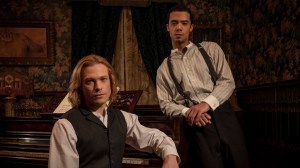On Wednesday, Batman #78 hit store shelves and delivered something that fans and readers of Tom King‘s run have been waiting for since the much anticipated wedding between the titular hero and longtime love Catwoman fell apart last July: a true reunion between the two characters. For some readers that moment was too little, too late as they are still unhappy with the way the wedding issue played out. For others, it was a solid issue setting up what should be an epic showdown with the Bat and the Cat against Bane for Gotham’s very soul. However, Batman #78 doesn’t just reunite Batman and Catwoman and set up for the end of the run. It drives home that the failed wedding was the best thing that ever could have happened to the Dark Knight in King’s run and maybe in the character’s entire history.
Videos by ComicBook.com
I know, claiming that the most controversial Batman moment in recent history — one that angered and disappointed many fans — may also be the best and most important is bold claim. I’m not just a critic, I’m a lifelong Batman fan as well. I’ve spent countless hours poring over the pages of Detective Comics and other stories allowing myself as a reader to go on the Dark Knight’s adventures. I’m well-versed. However, there are three points that I think support the claim: how the failed wedding humanized Batman, how Batman became his own worst villain in the aftermath, and the emotional growth that Batman has shown specifically in issue #78. These three things all come together to create the best and most satisfying version of the character in comics to date and it all flows from issue #50.

First, let’s talk about how the failed wedding humanized Batman. One of the things we see in the issues immediately is that Batman has dealt with the heartbreak of being left at the altar precisely as you’d expect Batman to. He’s gotten even harder on the criminals of Gotham, but as the “Cold Days” story arc unfolds in issues #51 through #53 both the reader and Bruce Wayne himself start to see that that particular tactic isn’t working. The issues tell two stories, one of Bruce Wayne serving jury duty in the trial of Victor Fries/Mr. Freeze while the other tells the story of how Freeze ends up on trial — the actions of Batman. As the trial and deliberations play out readers see both the hero and the man unravel. Batman, blinded by his pain and grief, went too far with his pursuit of Freeze and Bruce ultimately realizes this and then must convince the jury to find the villain not guilty as Bruce realizes that not only has he lost faith in God (it comes up in the jury deliberations) but he’s lost faith in himself, in Batman. He later tells Alfred that he has to remember who he is.
This is significant as it is one of the rare few times readers ever see Batman in a situation where he no longer trusts himself. This is the World’s Greatest Detective, after all. He is almost always right, but this time he wasn’t, not really. The devastation of the failed wedding triggered the kind of trauma response in Batman that led him to make a large enough mistake that he knows he’s hit rock bottom. He’s failed. It’s something that, in a metaphorical sense, strips away the cape and cowl and leaves readers with a man that they can identify with.

The flip side of that humanization of Batman as brought on by his post-heartbreak actions is that Batman has now also become his own enemy. This brings us to point two. By creating a situation wherein he no longer trusts himself — and by extension one in which the citizens of Gotham can see Batman as being fallible — he has contributed to the problems of Gotham. That’s not to say that he’s become a villain; even with his mistakes with Mr. Freeze Batman is still a “hero” in the grand scheme. What’s happened is that the entire fragile system of things with Batman has destabilized. He’s lost his allies. He’s lost himself. Batman is now his own enemy. He punches Commissioner Gordon. The Bat Signal is destroyed. He’s spiraling out of control. At this point in the story, readers are no longer dealing with a Batman that shoves aside his pain and just keeps punching things. King could have ended his post-wedding fallout with Freeze’s acquittal and simply opened a new chapter in which Batman goes back to using violence as a path to justice and a path far, far away from any further introspection. But he doesn’t. Instead, by pushing Batman even further into his own hell readers are getting a richer, more uncomfortable tale than what they’re used to.
That discomfort ends up having a purpose, which brings us to the third point. King doesn’t just have Batman get his heart broken and then send him on a spiral of self-doubt and hate. He forces Batman to grow emotionally and as a person. I’ll be the first to admit it, I was not a fan of the “Knightmares” arc. There were some issues that were better than others, but overall, I couldn’t quite figure out why we needed to keep kicking Batman while he was down. Now, though, that reason is a bit clearer. In “Knightmares” we see Batman quite literally fight through his own psyche with each part forcing him to face elements of himself and what he’s been through. In a sense, this mirrors therapeutic trauma work and it works because Batman has no shortage of trauma. It’s literally what the character is built on. In “Knightmares” there’s no escaping that trauma because he’s stuck in his own mind and it is only by working through things that he is able to wake up and break out of the drug-induced sleep he’s in. Yes, the drugged sleep is a metaphor for the pain holding Batman back and when he works through it, that’s when he wakes up.
The full payoff of that work and that growth becomes apparent in #78. Batman is fully defeated. Gotham has fallen to Bane. Batman himself was nearly killed. He is at the weakest point in his history, but in this issue, we see the character rise. He and Catwoman are coming together to try to take down Bane, yes, but Batman’s rise is less about the character getting back his physical strength it’s about him owning his mistakes, his pain, his trauma, and accepting that failed wedding in #50 is as much on him as it is on Catwoman. The long, painful downward spiral that issue kicked off took the hero and readers down has ultimately left us with a new Batman, a hero that can recognize his own flaw and faults, a hero knows that as much as Gotham needs Batman, Batman needs his humanity.
This is the Batman we’ve needed and now we have him, thanks to that failed wedding.








